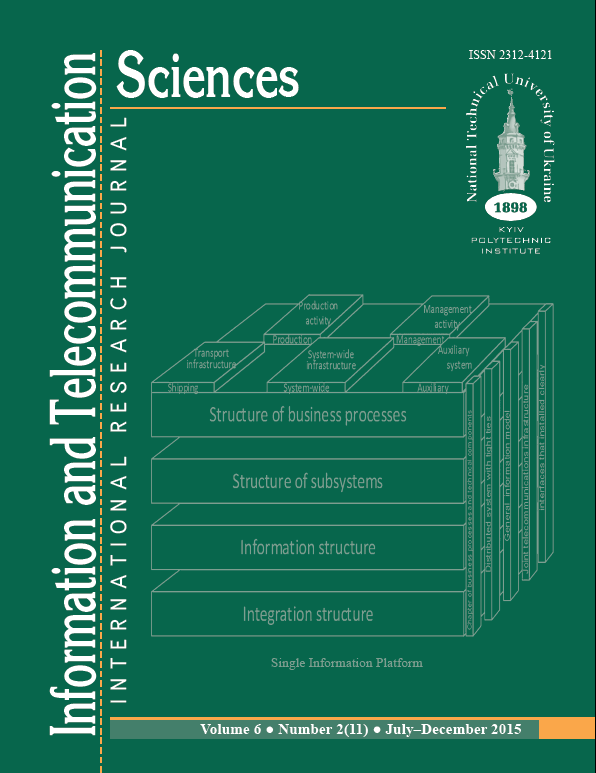BUILDING PRINCIPLES OF THE NETWORK RESOURCES AND THE NETWORK SERVICES PLATFORM ARCHITECTURES
DOI:
https://doi.org/10.20535/2411-2976.22015.25-35Keywords:
information and communication systems, telecommunications operator, information systems architecture and platforms of network resources and network services.Abstract
Background. Task of automation of productive and administrative processes, operating activity, general system providing, and also facilities, that provide creation, treatment, maintenance, moving away and transporting of information is actual. The united system of business processes allows conducting the synthesis of information and communication systems for national operator of telecommunications and informatization industry.
Objective. The objective is to develop the information systems architecture and the platforms of network resources and network services which are based on conception of the information and communication systems synthesis that automate the production and management processes, operation activities, production means and system-wide ensuring of the telecommunications operator.
Methods. The method of the communications infrastructure synthesis that receives convergent properties to provide personalized services to the end user, which is based on the developed methodology and methods and allows the client to implement the principle of self-configuration services to get the whole range of modern converged information and communication services to the agreed quality (QoS) is proposed.
Results. Architectures of telecommunication services capital of telecommunication operator are considered, which include the platforms of network resources and network services. The method of synthesis of communication infrastructure which gets convergence properties for the grant of personally services for end user is offered.
Conclusions. Description of methodological bases of synthesis of information-communication systems of telecommunication operator is presented, here, the synthesis of the systems is given by possibility to create the unique informative platform which is presented as universal architecture information and communication systems.
Keywords: information and communication systems, telecommunications operator; information systems architecture and platforms of network resources and network services.
References
V. Redko, I. Sergienko, A. Stukalo application systems. Architecture, construction, development. - K.: Nauk. dumka, 1992. - 320 p.
V. Repin, V. Elyferov Process approach to management: Business Process Modeling. - M .: RIA "Standards and quality" 2004. - 408 p.
Rinks, D., A heuristic approach to aggregate production scheduling using linguistic variables: Methodology and Application” in Yager R.R.(ed.) “Fuzzy Set and Possibility Theory”, Recent advances. / - M .: Radio and Communications, 1986. - 408c.- 408s.
O. Kopeika, I. Tarasenko, A. Kisselevskiy, A. Karichenskiy, T. Valiulin. Softline applies TM standards as a guide when building Resource Inventory solution for nation-wide carrier Ukraine Telecom // TM Forum Case Study Handbook, Volume 3, May 2007. - P. 27.
A. Shmalko The digital telecommunications network: Fundamentals of Scheduling and building a. - M .: Eko-Trendz, 2001. - 282 p.
CCITT Recommendation X.700 (09/92): Data Communication Networks: Management framework for Open Systems Interconnection (OSI) for CCITT applications / International Telecommunications Union.
- Geneva, 1992.
Choi M.-J., Hong J.W.-K. Towards Management of Next Generation Networks // IEICE Transaction Communications E Series B. - 2007. - Vol. 90. - No. 11. - P. 3004-3014.
Rubinstein, M, Duarte OC, Pujolle G. Evaluating the Network Performance Management Based on Mobile Agents // Proc. of 2nd International Workshop of Mobile Agents for Telecommunication Applications (MATA), Paris, France, September 2000.
O. Kopiyka, The architecture of network in the modern data-centers /O. Kopiyka// Scientific notes Ukrainian Research Institute of Communications. - 2014. - № 2 (30). - P.34 - 41.

